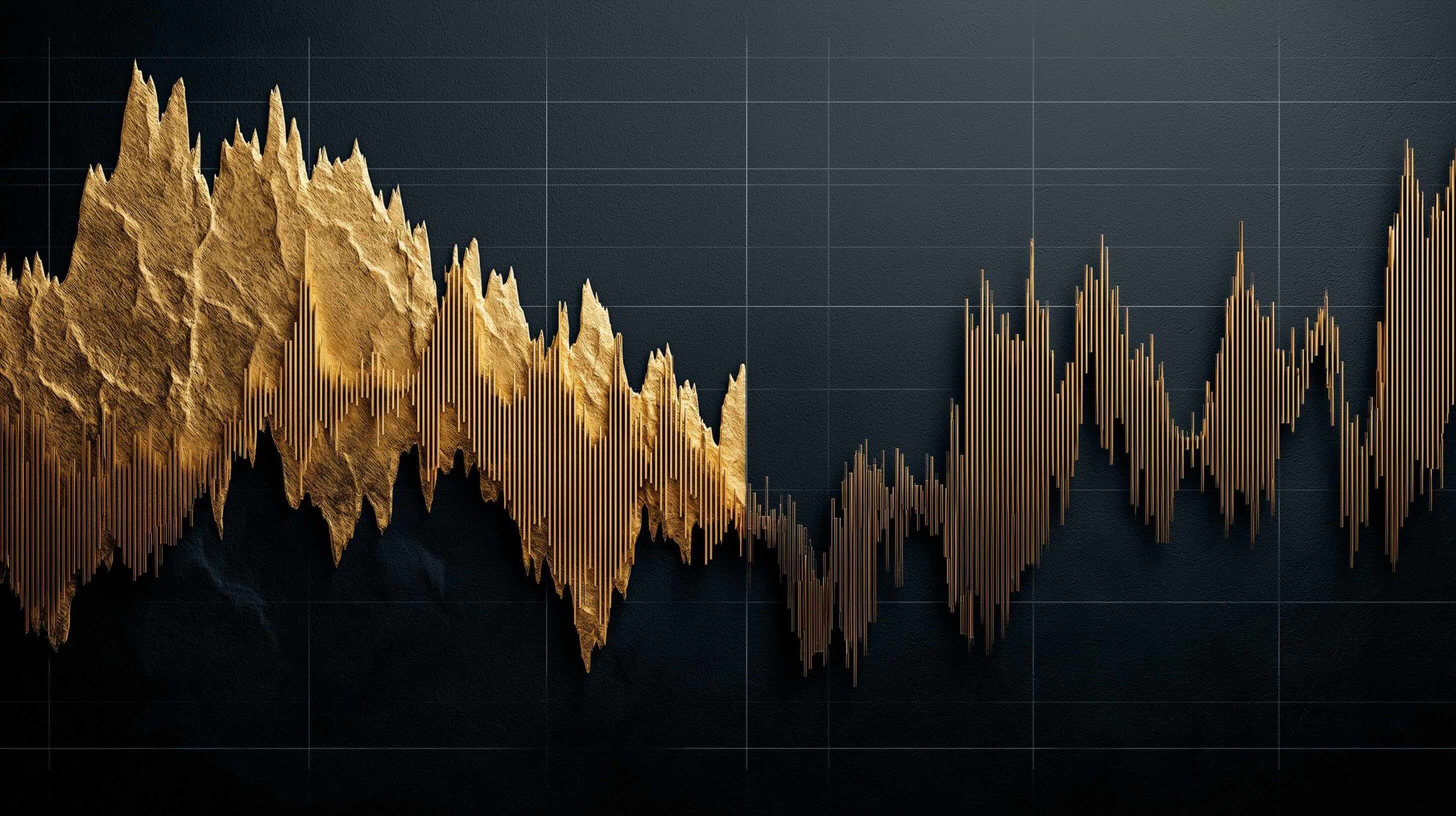- Certain months consistently outperform: Historical data reveal that gold prices and tech stocks tend to spike during specific months each year. For example, gold (GLD) has typically rallied in January, August, and April, while faltering in November [1]. Meanwhile, the Nasdaq-100/QQQ often suffers in September but enjoys a “winter rally” from November through March, with tech stocks posting some of their strongest gains during these months [2]. Seasoned traders watch these recurring patterns closely.
- Not just superstition – it’s statistical: “It’s not about guessing,” says analyst Gavin McMaster. Seasonality highlights recurring market behavior, which, when combined with technical signals or options data, can add an extra edge for investors [3]. In other words, knowing the market’s historical calendar helps stack the odds in your favor.
- 2025’s big twist: So far, 2025’s market has defied some seasonal norms. The S&P 500 and Nasdaq surged to fresh record highs in late September, a month that is usually weak [4]. Gold smashed past $4,000/oz for the first time ever in October, soaring ~52% year-to-date as of Oct. 10 [5]. Both stocks and gold are up big together – a rare combo signaling a mix of risk-on optimism and risk-off hedging [6]. This unusual alignment suggests other forces (like the AI boom and Fed rate cuts) overpowered typical seasonal trends [7] [8].
- Q4 is historically the strongest quarter: The October–December period has been the stock market’s most consistently positive quarter. Since 1950, Q4 has on average delivered the highest three-month returns of the year [9], often boosted by a late-year “Santa Rally” in December. Analysts note that when stocks break records in September (as in 2025), Q4 tends to be even stronger, with one study finding only one fourth-quarter loss in the past 8 instances of that scenario [10]. This seasonal tailwind has many on Wall Street eyeing a potential year-end rally.
- Experts see opportunity – but not a sure thing: The Stock Trader’s Almanac is boldly predicting a “monster Q4 rally” in 2025, arguing that because the usual summer slump never materialized, “more powerful forces are at play” and the bull market could accelerate [11]. They even project the S&P 500 could reach ~7100 by year-end (another ~20% gain) if history rhymes [12]. Other strategists urge some caution, noting high valuations and geopolitical risks. Seasonal patterns aren’t guarantees, they stress – but understanding them can help traders refine their timing and risk management [13].
Understanding Stock Market Seasonality
What if the best trades of the year were already marked on the calendar? This intriguing idea lies behind market seasonality – the tendency of certain assets to perform better (or worse) during particular times of the year. Rather than basing trades purely on hunches or headlines, some investors look at decades of data to identify recurring monthly patterns in prices. Historical seasonality can reveal when gold prices typically soar or when tech stocks often stumble, for example, providing a statistical edge in decision-making [14] [15].
Seasonality on its own isn’t a crystal ball, but it serves as a contextual tool. “Seasonality helps identify recurring market behavior — and when combined with technicals or options data, it can add an extra edge,” explains Gavin McMaster, a trading strategist who recently demonstrated these patterns in a webinar [16]. By aligning investments with historical trends, traders aim to “put probability on [their] side” [17]. Below, we dive into two standout examples – gold and technology stocks – to see seasonality in action.
Gold’s Seasonal Strength: Why January (and August) Shine
Gold has a well-known seasonal rhythm. SPDR Gold Shares (GLD) data over 15+ years show that January consistently stands out as one of gold’s strongest months [18]. “January consistently stands out… That could be linked to the Chinese New Year or broader market cycles,” notes McMaster [19]. In many years, demand from Asia tends to spike early in the year (ahead of Lunar New Year festivities when gold gifts are popular), giving gold prices a seasonal boost. Late summer is another strong period – gold often rallies in August, which market veterans attribute to factors like the Indian wedding season and mid-year investment flows. Even April has historically delivered solid gains for gold [20].
On the flip side, November has been gold’s weakest month on average [21]. This dip could be due to investors rotating into riskier assets near year-end or simply pausing after big autumn moves. The key is that these patterns repeat frequently. A trader aware of gold’s tendencies might plan to build positions in late December or during summer dips, anticipating the typical January or August strength. McMaster suggests combining these seasonal cues with technical confirmation – for instance, waiting for a trendline breakout or an oversold RSI signal in early January to time a gold entry [22]. By doing so, one can align with gold’s historical tailwinds while still respecting real-time market signals.
It’s important to note that 2025 has been an exceptional year for gold. Prices smashed through $4,000/oz for the first time in October 2025, reaching an intraday high around $4,059 on Oct. 8 [23]. As of Oct. 10, gold is hovering near $3,975 – up a staggering ~52% year-to-date [24]. That dwarfs stock market gains this year and far exceeds gold’s typical annual moves. Investors flocked to gold as a safe-haven amid economic and geopolitical jitters, from war tensions to concerns about U.S. debt [25] [26]. Seasonally, gold often cools in November, so some analysts wonder if a pullback is due. “It seems as good a time as any for gold bulls to book some profits. Still, any pullback could be limited,” one commodities analyst noted [27] [28]. The consensus is that gold may consolidate after its steep rise, but unless there’s a major improvement in the macro backdrop (e.g. booming economy or rising real interest rates), significant drops aren’t expected [29]. In short, gold’s seasonal pattern suggests caution into late fall – yet the supportive forces (low rates, global uncertainty) that drove it to records in 2025 could keep a floor under prices.
Tech Stocks’ Winter Rally: The November–March Effect
If gold heats up in winter, tech stocks practically catch fire. Historical charts of the Nasdaq-100 index and the Invesco QQQ ETF (which tracks the Nasdaq-100) reveal a striking pattern: November through March is consistently the strongest stretch for tech stocks [30] [31]. This phenomenon has been dubbed the “winter tech rally.” Over the past 15 years, the Nasdaq has shown outsized returns in those five months, often far above its performance in other parts of the year. What’s behind this seasonal surge? Several factors seem to align: holiday shopping and sales boost big tech revenues in Q4, governments and companies flush out budgets (spurring IT spending) in the new year, and the earnings season in January/February often brings optimism for tech giants. As McMaster observes, “from November through March, tech stocks show some of the strongest returns on record.” [32]
By contrast, September has been a consistent weak spot for tech. “September historically is the weakest month for QQQ,” McMaster notes [33]. Indeed, traders are all too aware of the stock market adage, “Beware the September swoon.” Whether due to investors returning from summer vacations and rebalancing portfolios, or pre-Q4 jitters, early autumn often sees tech stumble. In many years, savvy investors use September pullbacks in Nasdaq or QQQ as buy-the-dip opportunities ahead of the winter rally. A common strategy is to position bullishly in late October or early November – for example, buying call options or call spreads on QQQ in early November with expirations in February/March, aiming to ride the historical uptrend during those months [34]. According to the seasonal stats, this window has rewarded such patience more often than not.
2025’s tech sector performance has been unusual relative to typical seasonality. Rather than sagging in late summer, the Nasdaq powered to new all-time highs in August and September 2025, propelled by a frenzy over artificial intelligence. The index notched eight new record closing highs in September alone, a month that normally yields middling or negative returns [35]. “So much for ‘Sell in May’ this year,” joked the Stock Trader’s Almanac after witnessing this five-month streak of market gains [36]. Big tech’s momentum, fueled by booming AI investments and massive chipmaker rallies, essentially overrode the usual September slump. One contributing factor: investors anticipating Federal Reserve rate cuts and lower yields, which tend to lift growth stocks (like tech) regardless of the calendar. In effect, 2025’s bull market shrugged off the usual seasonal speed bumps – a sign that, as the Almanac put it, “more powerful forces are at play” than seasonality alone [37].
Now in mid-October 2025, with Q4 underway, the stage could be set for the traditional winter rally to continue – unless something big intervenes. The Nasdaq-100 has recently been around 25,000 (a record level) after roughly a +20% gain year-to-date [38]. Many of the so-called “Magnificent 7” mega-cap tech stocks (Apple, Microsoft, Alphabet, Amazon, Nvidia, Meta, Tesla) are up significantly this year, bolstered by AI hype and robust earnings growth. That creates a favorable backdrop entering the winter months that are usually kind to tech. However, risks remain: valuations are elevated after such a run, and any disappointments from the tech sector (or a resurgence of inflation prompting the Fed to rethink policy) could temporarily douse the seasonal rally. Analysts at LPL Financial note that after a 5-month market “melt-up,” some cooling off or volatility is possible in the short term – but they “would consider [any dip] a potential opportunity to buy,” especially with a seasonally strong fourth quarter ahead [39]. In other words, even if 2025 hasn’t followed the usual script up to now, the historically bullish winter period could still work its magic – provided no shock events upset the trend.
2025: When Seasonal Trends Collide with Surprising Realities
The year 2025 is proving to be a fascinating case study of seasonality vs. reality. On one hand, we have these well-established patterns (gold’s January jump, Nasdaq’s winter strength). On the other hand, markets often find ways to surprise us, and this year has been full of surprises. Consider the old saying “Sell in May and go away” – implying stocks often underperform from May through October. In 2025, that advice would have backfired badly: the S&P 500 has soared roughly 33% from the April lows through September [40], and the index posted gains in each of the five months from May to September [41]. Historically, such a five-month winning streak is rare and bullish: in over 70 years of data, the S&P has never been down a full year in the aftermath of a 5-month up streak [42]. This explains why some experts remain optimistic that the rally has legs into 2026, seasonal norms aside.
A big factor in 2025’s market strength has been the Federal Reserve’s policy pivot. After a long stretch of interest rate hikes to combat inflation, the Fed made its first rate cut in September 2025 and is widely expected to cut rates again at its late-October meeting [43] [44]. This easier monetary policy is like rocket fuel for stocks – lower borrowing costs, higher valuations – and it’s also a boon for gold, because rate cuts tend to weaken the dollar and lower bond yields (making non-yielding assets like gold more attractive) [45]. Thus, the Fed’s U-turn provided an extra push that amplified the usual year-end seasonality. Stocks and gold rallying in tandem – as they have in 2025 – is highly unusual, and it “speaks to a bifurcated market psychology: optimism on innovation, but hedging against risk,” one analyst observed [46]. Essentially, investors have been greedy and fearful at the same time – chasing high-growth tech opportunities (greed) while also snapping up safe-haven gold (fear). This unique mix has overpowered typical seasonal pullbacks so far.
Other news and anomalies around early October played into the narrative as well. A brief U.S. government shutdown began on Oct. 1, but it barely dented market confidence – historically such shutdowns have had minimal lasting market impact [47]. Indeed, by Oct. 3 the S&P 500 and Dow were hitting fresh all-time highs despite the political drama [48]. Geopolitical flare-ups, like a conflict in the Middle East in early October, gave gold a momentary lift but did not halt the equity rally once a ceasefire was reached [49]. And underpinning everything is the ongoing AI revolution: massive investor enthusiasm for artificial intelligence has driven tech stocks sharply higher (e.g. chipmaker Nvidia’s stock climbing ~40%+ this year) [50]. This hype cycle provided a fundamental “reason” for the market to buck seasonal weakness. As Mona Mahajan of Edward Jones put it, “Momentum is on the side of investors… the chance of Fed rate cuts has actually risen since the shutdown began,” keeping the focus on the positive drivers [51].
In short, 2025 demonstrates that seasonal trends can be trumped by major catalysts. When “bearish seasonality doesn’t transpire, it is a bullish indication that more powerful forces are at play,” the Stock Trader’s Almanac explained [52]. Those forces – be it monetary policy shifts, technological breakthroughs, or fiscal stimuli – have created a tide that lifted markets even during normally soft months. Looking ahead, this could mean an even stronger late-year surge if the usual Q4 tailwinds kick in on top of an already powerful trend. Little wonder that the Almanac is calling for a “banner Q4 rally” to drive the S&P 500 toward record heights by New Year’s [53]. Still, prudent investors are not throwing caution to the wind. Valuations are stretched in some areas, and any disappointment (say, a weak earnings report or a snag in Fed easing plans) could bring a quick correction. The takeaway is to stay aware of seasonal probabilities, but remain agile if reality deviates from the script.
How Traders Use Seasonality to Trade Smarter
Identifying a seasonal pattern is only step one – the real question is how to trade it. Gavin McMaster and other strategists outline a few practical approaches to put seasonal insights to work:
- Trend-Following:Ride established seasonal trends by going long on markets or assets during their historically strong periods. For example, a trader might buy an S&P 500 index fund or large-cap stocks in the autumn to capture the typical Q4 rally, or accumulate gold in December ahead of its usual January jump [54]. The idea is to “go with the flow” of seasonal momentum rather than fight it. If history shows a market tends to rise in a given month, align your bullish trades accordingly (while still monitoring for confirming signals).
- Sector Rotation: Rotate your focus (and capital) between sectors throughout the year based on seasonal leadership. Different industries shine at different times – for instance, energy stocks often strengthen in late spring and summer (when oil demand peaks), whereas retailers and consumer stocks tend to rally in the pre-holiday months [55]. A seasonality-savvy investor might trim positions in sectors that are heading into historically weak periods and reallocate to sectors entering their seasonally strong period [56]. In 2025, for example, one could have shifted more into tech going into November, or into utilities in early autumn if history suggested defensives outperform as temperatures drop.
- Options Strategies: Use options to leverage seasonal moves or hedge against seasonal risks. Because options can target specific timeframes, they are well-suited to seasonal plays. Traders may buy call options or call spreads to bet on an expected upswing during a strong seasonal window (e.g. purchasing calls on QQQ in late October that expire in February) [57] [58]. This can generate amplified returns if the seasonal rally materializes, with limited downside risk (the premium paid) if it doesn’t. Conversely, one can buy put options as protection during seasonally weak periods – for example, buying puts on an index in late August to hedge against the notorious September swoon [59]. McMaster also suggests bull put spreads (a bullish options strategy) as a way to profit from expected seasonal strength while buffering against small dips [60]. These option tactics allow traders to fine-tune their exposure around the calendar’s twists and turns.
No matter the strategy, experts stress the importance of confirmation and risk management. Seasonality can tell you what tends to happen most of the time, but “you can’t predict the market” with certainty [61]. Using tools like Barchart’s Seasonal Returns calculator (which visualizes multi-year average returns by month) [62] [63] or scanning for technical signals aligning with seasonal inflection points can improve confidence in a trade. For instance, if you know November is typically strong for the Nasdaq, you might still wait until early November shows a technical breakout or an encouraging earnings report before fully piling in. Many traders also set stop-losses and profit targets on seasonal trades, recognizing that even the most reliable patterns sometimes fail due to unforeseen events.
It’s also worth noting that seasonality isn’t just about broad stock indexes or commodities – it can be applied to individual stocks and other assets. Certain companies have predictable cycles (retailers do well in Q4 holidays, toy manufacturers spike before Christmas, etc.), and even cryptocurrencies and foreign markets exhibit seasonal quirks. The key is research: dig into historical data (5, 10, 20+ years if possible) and identify those recurring peaks and troughs. Armed with that knowledge, an investor becomes a bit like a farmer planting seeds ahead of the rainy season – anticipating fertile conditions for growth, rather than reacting after the fact. As one market veteran quipped, “History doesn’t repeat, but it often rhymes.” Seasonality is about listening to those rhymes and adjusting your portfolio in harmony.
Outlook: Will 2025’s Year-End Follow the Seasonal Script?
With early October behind us, attention turns to the final quarter of 2025. The big question: will the classic seasonal patterns hold true this time around? Historical odds favor a strong finish – Q4 has been the stock market’s most positive quarter on average [64], and years with robust gains through September often keep running through December [65]. The backdrop certainly has supportive elements: the Fed is easing policy (rate cuts are generally stock-friendly), inflation has been trending lower, and the holiday season is expected to unleash healthy consumer spending. Those factors, combined with the natural seasonal bias, suggest the path of least resistance may be upward into year-end.
Many analysts are accordingly upbeat. The Stock Trader’s Almanac team, known for crunching seasonal data, is perhaps most bullish – citing the lack of a summer correction as a green light, they foresee a “monster rally” driving the S&P 500 toward ~7100 by December [66] [67]. (For context, the S&P was around 6,700 in early October, already a record level [68].) Such a surge would require continued strong sentiment, especially in the tech sector, and no major negative shocks. Wall Street strategists at major banks are more mixed: some have raised their year-end targets for the S&P 500 given the momentum (Goldman Sachs recently upped its 2025 target to ~6,800) [69], while others warn that returns might be more muted from here due to rich valuations.
Key things to watch in the coming weeks include: earnings reports from big tech and consumer companies (strong results could fuel the rally, while any high-profile miss might spook investors short-term); Fed communications around the late-October meeting (the market is pricing in a quarter-point rate cut – anything different could jolt markets); and any developments on the geopolitical front (e.g. renewed tensions or unforeseen crises could drive a temporary flight to safety). Barring any big surprises, the general sentiment is that any pullbacks this fall could be “relatively brief and shallow,” as the Almanac put it [70]. In practice, that means dips of a few percent could quickly attract buyers who feel they “missed out” on the rally – a dynamic that often propels markets higher into the new year.
From the perspective of seasonal traders, now is a time of excitement but also discipline. Those who rode the uncommon summer strength are sitting on nice profits – they’ll be watching when to rotate or hedge if year-end brings the gains it usually does. Those who were on the sidelines are tempted to jump in to catch the famed “Santa Claus rally” (typically the last week of December and first two trading days of January, which historically are positive more often than not). However, jumping in blindly is never wise. Experts advise to still be selective: focus on quality companies and assets that have momentum and fundamental support, even as you lean on seasonal tailwinds.
One interesting factor this year is the duel between risk assets and safe havens. In a typical year, if stocks charge ahead in Q4, gold might retreat (as investors feel less need for protection). Yet in 2025, gold has been marching higher alongside stocks. Will that continue? Some analysts suspect that if the stock rally roars into late Q4, gold could finally see a pause or correction, which would fit its seasonal pattern of winter cooling. Others argue that with central banks buying gold and global uncertainties still simmering, gold might hold firm or even keep climbing albeit at a slower pace. For traders, this could mean diversification remains key – participating in the stock rally while maintaining some hedge in case things go awry. After all, if 2025 has taught us anything, it’s to expect the unexpected.
Bottom Line: Using Seasonality Wisely
Seasonal trends are a powerful tool in an investor’s toolkit, but they are not foolproof prophecies. “Seasonal data doesn’t guarantee profits, but it gives you context,” as one Barchart report concluded [71]. By knowing when assets tend to outperform or struggle, you can tilt the odds in your favor and refine your timing – essentially trading with the wind at your back [72]. The experience of 2025 underscores that while the calendar can hint at market direction, it’s no substitute for vigilance and adaptability. Unexpected news can and will derail even the most reliable seasonal pattern now and then.
Going forward, a prudent approach is to embrace seasonality as a guide, not a rulebook. Plan your trades around historical sweet spots (like gold’s new-year strength or stocks’ Q4 rally), but also plan for contingencies. Use stop-loss orders, stay diversified, and keep an eye on the macro forces that might override the calendar. As Gavin McMaster reminds traders, seasonality is about putting probability on your side, not predicting the future with certainty [73]. In the closing months of 2025, that means being optimistic – history favors a strong finish – yet prepared to adjust if this year continues to break the mold. By blending seasonal wisdom with real-time analysis, investors can navigate the rest of 2025 and beyond with a balanced mix of confidence and caution.
Sources: Historical performance data and expert commentary on seasonality (G. McMaster via Barchart) [74] [75]; 2025 market statistics from TS2 and Reuters (gold +52% YTD; Nasdaq-100 +20% YTD; record index levels) [76] [77]; Stock Trader’s Almanac outlook [78] [79]; LPL Financial research on monthly/quarterly trends [80] [81]; Investopedia/WSJ market news (Oct. 2025 records, shutdown) [82] [83]; and additional analysis from TS2.tech on 2025’s dual rally (AI-driven stock boom vs safe-haven demand) [84] [85]. All information is up to date as of Oct. 10, 2025.
References
1. www.farmersgrainelevator.com, 2. www.farmersgrainelevator.com, 3. www.farmersgrainelevator.com, 4. www.investing.com, 5. ts2.tech, 6. ts2.tech, 7. www.investing.com, 8. ts2.tech, 9. www.lpl.com, 10. www.investing.com, 11. www.investing.com, 12. www.investing.com, 13. www.farmersgrainelevator.com, 14. www.farmersgrainelevator.com, 15. www.farmersgrainelevator.com, 16. www.farmersgrainelevator.com, 17. www.farmersgrainelevator.com, 18. www.farmersgrainelevator.com, 19. www.farmersgrainelevator.com, 20. www.farmersgrainelevator.com, 21. www.farmersgrainelevator.com, 22. www.farmersgrainelevator.com, 23. ts2.tech, 24. ts2.tech, 25. ts2.tech, 26. ts2.tech, 27. ts2.tech, 28. ts2.tech, 29. ts2.tech, 30. www.farmersgrainelevator.com, 31. www.farmersgrainelevator.com, 32. www.farmersgrainelevator.com, 33. www.farmersgrainelevator.com, 34. www.farmersgrainelevator.com, 35. www.investing.com, 36. www.investing.com, 37. www.investing.com, 38. ts2.tech, 39. www.lpl.com, 40. www.lpl.com, 41. www.lpl.com, 42. www.lpl.com, 43. ts2.tech, 44. ts2.tech, 45. ts2.tech, 46. ts2.tech, 47. ts2.tech, 48. ts2.tech, 49. ts2.tech, 50. ts2.tech, 51. ts2.tech, 52. www.investing.com, 53. www.investing.com, 54. www.farmersgrainelevator.com, 55. www.farmersgrainelevator.com, 56. www.farmersgrainelevator.com, 57. www.farmersgrainelevator.com, 58. www.farmersgrainelevator.com, 59. www.farmersgrainelevator.com, 60. www.farmersgrainelevator.com, 61. www.farmersgrainelevator.com, 62. www.farmersgrainelevator.com, 63. www.farmersgrainelevator.com, 64. www.lpl.com, 65. www.investing.com, 66. www.investing.com, 67. www.investing.com, 68. ts2.tech, 69. ts2.tech, 70. www.investing.com, 71. www.farmersgrainelevator.com, 72. www.farmersgrainelevator.com, 73. www.farmersgrainelevator.com, 74. www.farmersgrainelevator.com, 75. www.farmersgrainelevator.com, 76. ts2.tech, 77. ts2.tech, 78. www.investing.com, 79. www.investing.com, 80. www.lpl.com, 81. www.lpl.com, 82. www.investopedia.com, 83. ts2.tech, 84. ts2.tech, 85. ts2.tech









